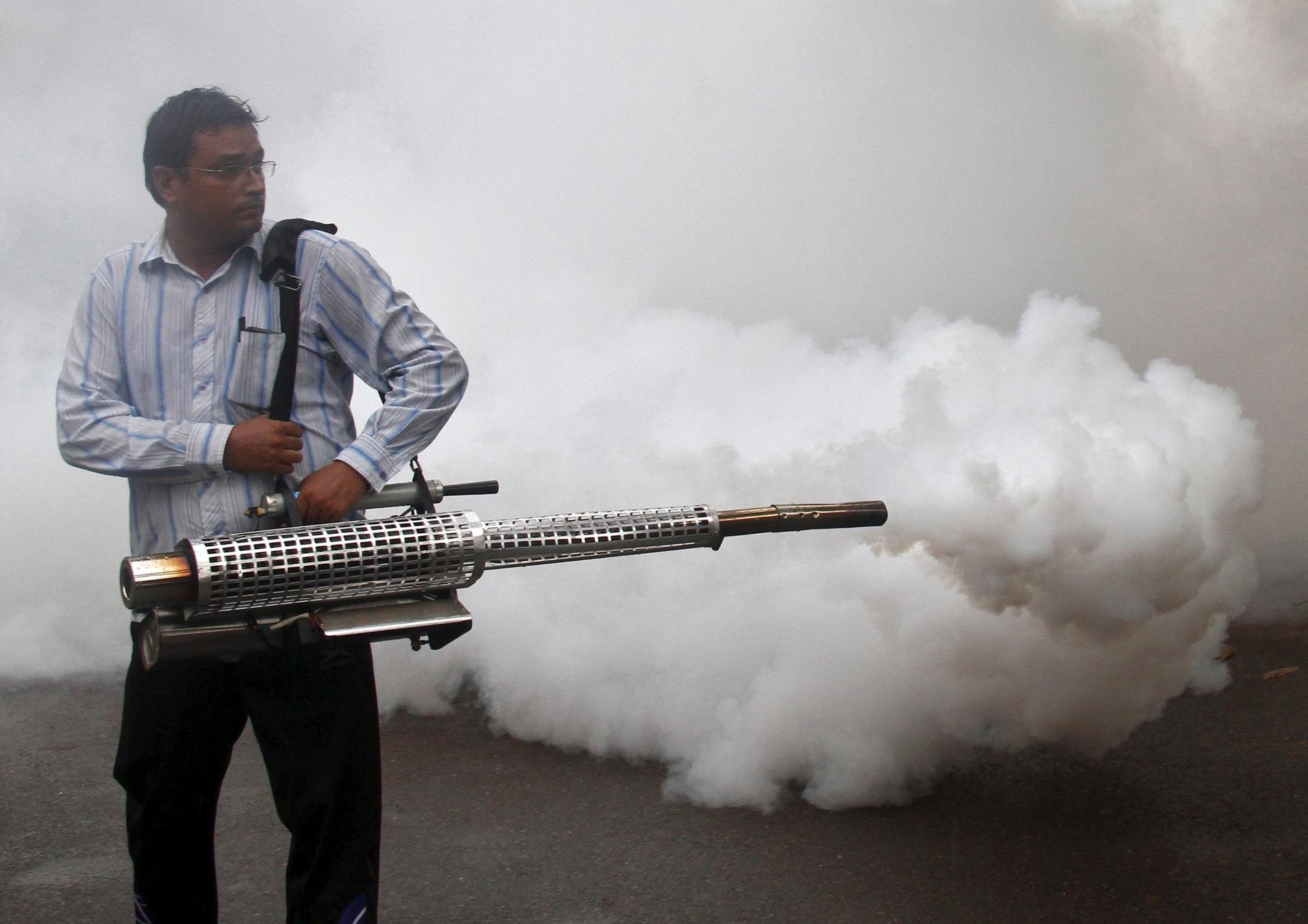India struggles to get a handle on mosquito-borne diseases
A health worker fumigates a residential area to prevent the spread of dengue fever in Chandigarh, India, September 20, 2015. Dengue, a mosquito-borne disease, is common in India and the number of cases generally peaks in October, after the end of the monsoon rains.
When it comes to mosquito-borne diseases, the world’s attention has been fixated on Zika for the past year. But other diseases like malaria or dengue still threaten more people.
This is particularly true in India, a country with a population of 1.2 billion, where the government is struggling to get a handle on the problem — though there are signs of hope.
To understand the stakes, look no further than the capital, New Delhi, where this summer an outbreak of chikungunya affected thousands with fever and joint pain. This was soon followed by the seasonal dengue epidemic, a more severe virus that can be fatal.
Climate change, rapid urbanization, a growing population and lack of sanitary waste and water disposal are all factors that have allowed dengue and chikununya to thrive in New Delhi. But Dr. Ashish Bhatia, a physiotherapist based in the city, is one of many critics who have blamed the Delhi government for its slow reaction to the outbreak. Late fumigation drives and in-fighting between different government bodies have made things worse this year.
Over the past few months, Bhatia has seen eight to 10 patients a day with chikungunya.
“Until about 10 years ago, nobody knew about dengue and chikungunya. Now the problem is that in the big metros there are more and more people within the same infrastructure and this has created more waste, which is not disposed of properly. This is why the mosquitoes have a very good ground for breeding. If you can’t stop mosquitos, you can’t prevent the disease from spreading,” he says.
Dr. Mohan Kalra practices internal medicine at Max Hospital in Delhi, one of the capital’s largest private hospitals. He says the country’s healthcare system still lacks the capacity to handle these seasonal outbreaks, and that authorities should have planned ahead better.
“Every hospital is overflowing — there are two patients per bed at times. When there was an epidemic, there were no beds available. People were treated in wheelchairs, on benches,” says Kalra.
The World Health Organization has called on India to strengthen its disease surveillance network, urging the government and private healthcare providers to have closer communication. According to the WHO, this would allow for a more reliable count of cases, which remain massively unreported. This is also true for other mosquito-borne diseases, like malaria and Japanese encephalitis.
But the government maintains it is working hard on the problem.
“In India, we are providing dengue, chikungunya and Japanese encephalitis diagnostic facilities from as many as 542 places, free of cost,” says Dr. Akshay Chandra Dharival, head of India’s National Vector Borne Disease Control Program.
He recognizes that malaria remains the county’s most pervasive problem, and says the Indian government is following the lead of some neighboring countries that are attacking the disease using a multi-pronged approach involving testing, treating and prevention. “We have launched our framework for malaria elimination in 2016 with the target to make India free by 2027,” Dharival says.
But India’s commitment to eradication has been challenged by a new study published in September by rhe British medical journal, The Lancet. It revealed India only spends about 1.5 percent of its total GDP on healthcare, what the authors called an alarmingly low number. Overall, in terms of quality of the health system, the country ranked in the bottom quarter of 188 countries surveyed.
However, that’s not the full picture, says Kayla Laserson, director of the US Centers for Disease Control and Prevention’s India office. The CDC set up shop in the country in 2001, with the goal of assisting India in fighting the spread of infectious diseases.
“It’s difficult to give India a number on anything like that because it is so vast and there are so many epidemiologic areas. India’s low compared to other countries, that’s true, but the programs that are in place in the country are still very strong,” she says.
Laserson insists there are efficient laboratories and strong disease surveillance in India.
“Our agenda is to strengthen laboratory detection, bringing diagnostics to more peripheral areas for example, quickening the response time for an outbreak investigation or having more people trained to investigate outbreaks. And it’s helpful in such a large country to have more of everything.”

India is also utilizing new methods, including biotechnology, to prevent mosquitoes from spreading diseases, says Dharival. But while there is promise in programs like this, implementation is going to take more political will and public involvement.
But there’s recent precedent for the country banding together to fight an infectious disease. Up until the early 1990s, polio was still rampant throughout India, infecting 500 to 1,000 people a day. An aggressive vaccination campaign began reversing the problem. Two years ago, India was finally declared polio free.
“It’s a question of intent, of being very proactive,” Bhatia says. “Look what has happened to polio in our country. So if we want, good things can happen.”
America Abroad is an award-winning documentary radio program that takes an in-depth look at one critical issue in international affairs and US foreign policy every month. You can follow them on Facebook, talk to them on Twitter, and subscribe to their weekly newsletter for updates.
